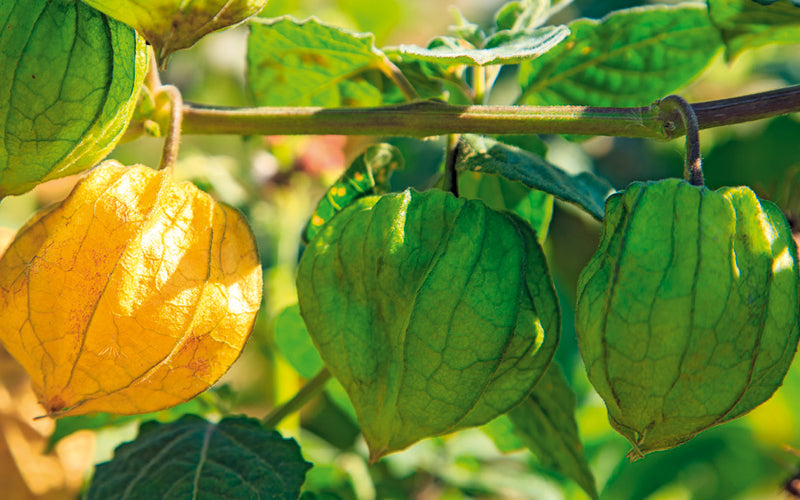Growing and harvesting Cape gooseberries (Physalis)
Andean berry, Inca plum, Cape gooseberry, Physalis peruviana, (Physalis edulis) These exotic-looking, delicious fruits with their lantern-like bracts are familiar from the supermarket or as edible decorations at buffets – we're all the more excited that Andean berries can be cultivated without much effort in the garden or in containers. This typical "snack fruit" regularly sweetens our summer gardening between the vegetable patches as a small snack.

What do Andean berries need to thrive?
Andean berries are heat-loving plants that prefer a sheltered, full-sun location. The soil or substrate (for potted plants) should be loose, humus-rich, and easily warm.
Where early frosts threaten in the fall, the fruit unfortunately usually doesn't ripen. A recommended alternative in this case is growing in pots, provided the pots are warm and protected. Andean berries are extremely drought-tolerant, but produce significantly more fruit when watered during the summer heat.
Growing in the bed
Pre-cultivate in pots on the windowsill from mid-February or sow outdoors from mid-May (sowing depth 1–2 cm). A temperature of 25°C is optimal for germination.
If pre-cultivation is required, transplant seedlings into larger pots after 2–3 weeks. Transplanting the plants into larger pots once more will accelerate their growth.
Plant out from mid/late May, pre-fertilizing the soil with compost. Plant 60 cm apart. Train the plants on stakes/strings to form multiple shoots, pinching off shoot tips.
Thinning like with tomatoes isn't absolutely necessary. Water regularly. Change location every 3–4 years; don't plant after tomatoes.
In the greenhouse
In our experience, Andean berries can be grown in a greenhouse similar to tomatoes, and they grow well there, but they usually develop more leaf mass than fruit. Furthermore, the fruits taste significantly less aromatic – hence our conclusion: greenhouse cultivation for Andean berries isn't really worth it!
In planters
Plant pre-grown plants in pots from mid-May onwards or sow directly into containers (sowing depth 1–2 cm). Containers should have a volume of 15–20 liters; for typical balcony varieties (e.g., 'Biscuit'), 10 liters is sufficient. Use tomato soil from a specialist retailer.
Place in a sunny, sheltered spot. Attach string or stakes, train plants to form multiple shoots, water regularly, and fertilize with a standard tomato fertilizer approximately 6–8 weeks after planting.
If there are still a lot of unripe fruits on the plants when frost begins, bring the pots into the house and let the fruits ripen there.
It is time to harvest!
Andean berries are ripe for harvesting from mid-July to October. They then change color from yellow to orange; the parchment-like bracts turn brown and dry out. Harvest berries with bracts; eat them raw or as jam; do not eat green berries!
Variety recommendations
- 'Biscuit': compact growth, good for pots/tubs, high yielding, aromatic, early harvest (mid-June)
- 'Peters Beste': broad and bushy growing, high yielding, very sweet
- 'Schönbrunner Gold': large-fruited, very aromatic
- 'Little Lanterns': compact growth, good for pots/tubs, high yield
- 'Little Buddha': vigorous, productive, very large fruit, pleasant sweet and sour aroma
Tips & Tricks about the Andean Berry
Andean berries can also be overwintered: frost-free at 5–10 °C, cool, and bright. Prune heavily beforehand, leaving only the main stems. Water only very sparingly.
If overwintering is successful, the harvest the following year can be larger. Overwintering in a heated living space is not advisable. Incidentally, Andean berries are actually considered vegetables.
← vorheriger Post: Propagating houseplants

The content of this article is from the book:
Renate Hudak, Harald Harazim
Harvest vegetables, fruit & herbs in no time
Over 45 types – quick and easy
Price: 17.95 €
ISBN 978-3-8186-1277-1
Eugen Ulmer Publishing House
Are you short on time but still want to grow vegetables, fruits, and herbs? This book introduces you to over 45 selected varieties that are quick and easy to grow. Ideal for gardening beginners and those with limited time and space!

























































































